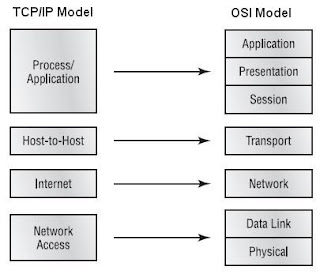The Transmission Control Protocol/Internet Protocol suite was created
by the Department of Defense (DoD) to ensure and preserve data integrity, as
well as maintain communications in the event of catastrophic war.
The DoD OR TCP/IP model is basically a condensed version of the OSI model , it composed of four, instead of seven, layer: 1. Process/Application Layer, 2. Host-to-Host/Transport Layer, 3. Internet layer, 4. Network Access Layer
The DoD OR TCP/IP model is basically a condensed version of the OSI model , it composed of four, instead of seven, layer: 1. Process/Application Layer, 2. Host-to-Host/Transport Layer, 3. Internet layer, 4. Network Access Layer
The TCP/IP Protocol Architecture
TCP/IP defines a large collection of protocols that allow
computers to communicate. TCP/IP defines the details of each of these protocols
inside documents called Requests for Comments (RFC). By implementing the
required protocols defined in TCP/IP RFCs, a computer can be relatively
confident that it can communicate with other computers that also implement
TCP/IP. An easy comparison can be made between telephones and computers that use
TCP/IP.
Layer 4: The TCP/IP Process/Application Layer
TCP/IP application layer protocols provide services to the
application software running on a computer. The application layer does not
define the application itself, but rather it defines services that applications
need—such as the capability to transfer a file in the case of HTTP.
The following protocol and application are used in Application /
process layer
* FTP
* HTTP
* DNS
* DHCP
* Telnet
* SMTP
* NFS
* LPD
* SNMP .etc....
In short, the application layer
provides an interface between software running on a computer and the network
itself. Arguably, the most popular TCP/IP application today is the web browser.
Many major software vendors either have already changed or are changing their
software to support access from a web browser. And thankfully, using a web
browser is easy—you start a web browser on your computer and select a website by
typing in the name of the website, and the web page appears.
Layer 3: The TCP/IP Transport OR Host-to-Host Layer
The main purpose of the Transport/Host-to-Host layer is to
shield the upper layer application from the complexities of the network. This
layer says to the upper layer, " Just give me your data stream, with any
instructions, and I will begin the process of getting your information ready to
send".
The TCP/IP application layer includes a relatively large number
of protocols, with HTTP being only one of those. The TCP/IP transport layer
consists of two main protocol options:
* Transmission Control Protocol (TCP)
* User Datagram Protocol (UDP).
Key features of TCP and UDP
Layer 2: The TCP/IP Transport OR Host-to-Host Layer
In the DOD OR TCP/IP model, there are two main reasons for the
internet layer`s existence: routing and providing a single network interface to
the upper layer.
The internet layer of the TCP/IP networking model, primarily
defined by the Internet Protocol (IP), works much like the postal service. IP
defines addresses so that each host computer can have a different IP address,
just as the postal service defines addressing that allows unique addresses for
each house, apartment, and business. Similarly, IP defines the process of
routing so that devices called routers can choose where to send packets of data
so that they are delivered to the correct destination.
The following protocol are used in this layer:
* IP (Internet Protocol)
* ICMP (Internet Control Message Protocol)
* ARP (Address Resolution Protocol)
* RARP ( Reverse Address Resolution Protocol)
* Proxy ARP
Layer 1: The TCP/IP Network Access Layer
The network access layer defines the protocols and hardware
required to deliver data across some physical network. The term network access
refers to the fact that this layer defines how to physically connect a host
computer to the physical media over which data can be transmitted.
The network access layer includes a large number of protocols.
For instance, the network access layer includes all the variations of Ethernet
protocols and other LAN standards. This layer also includes the popular WAN
standards, such as the Point-to-Point Protocol (PPP) and Frame Relay.
TCP/IP Protocol Suite




No comments:
Post a Comment